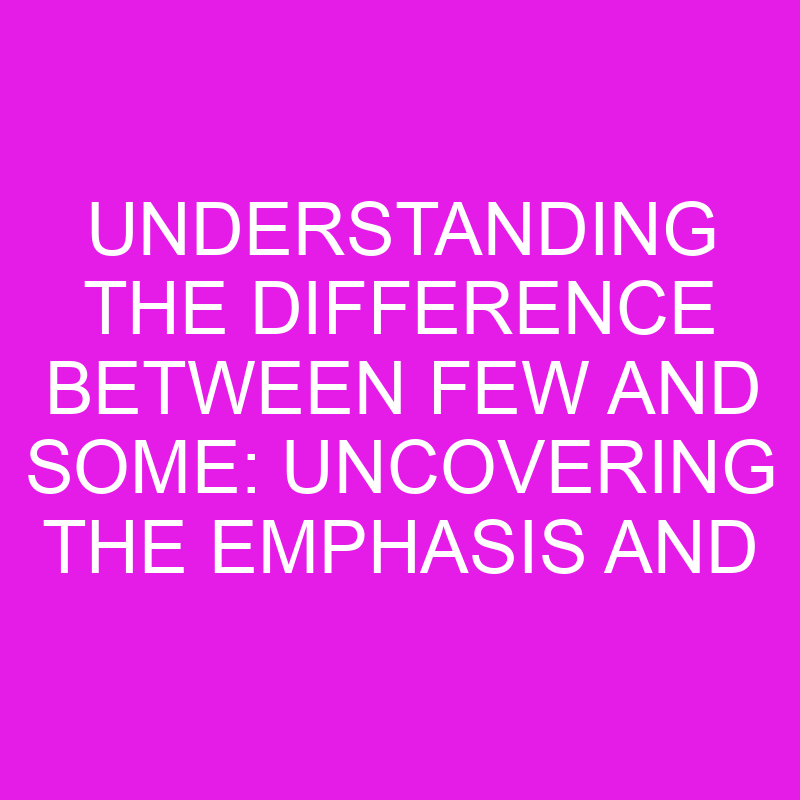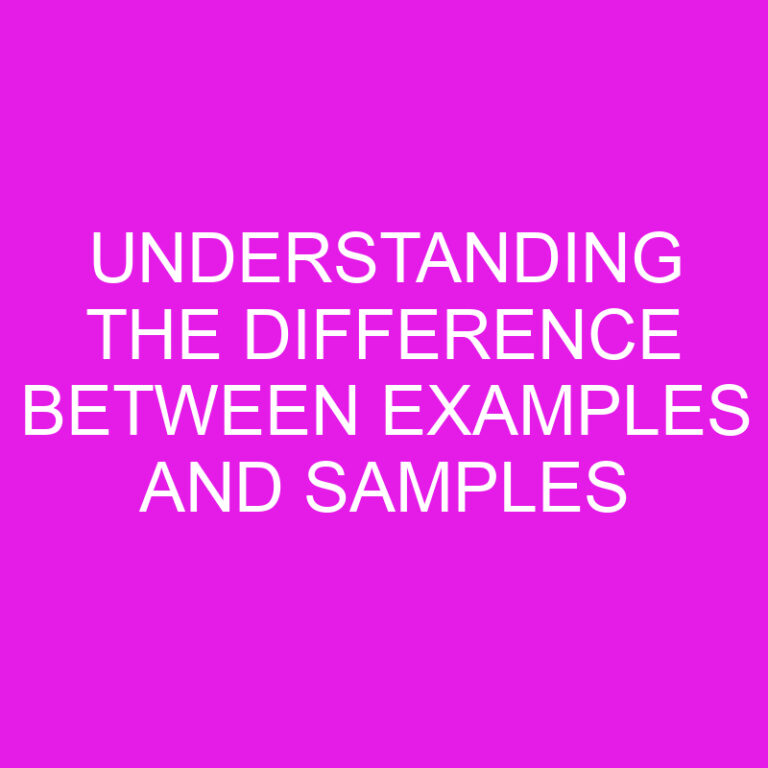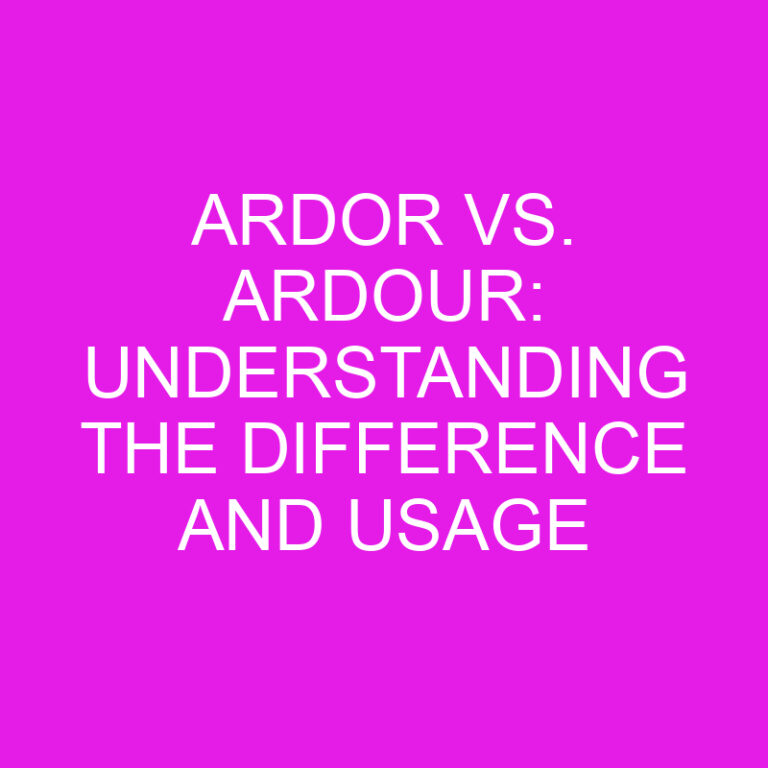
Hey there! Have you ever wondered about the subtle nuances between the words “few” and “some”? Well, you’re in the right place! In this article, I’ll be diving into the fascinating world of language and exploring the key differences between these two commonly used terms. Understanding when to use “few” and when to use “some” can make a significant impact on the clarity and precision of your communication. So, let’s get started and unravel the mysteries behind these seemingly similar words!
Post Contents
Key Takeaways
- “Few” refers to a small number or amount, emphasizing scarcity or limited quantity. “Some” suggests an unspecified quantity or number, indicating at least a small amount.
- “Few” and “some” are used with countable nouns. “Few” emphasizes scarcity or limited number, while “some” implies the presence of at least a small amount.
- “Few” cannot be used with uncountable nouns. “Some” is appropriate for uncountable nouns, indicating the presence of an unspecified quantity.
- “Few” emphasizes scarcity or limited quantity, while “some” indicates an unspecified quantity or number.
- Using “few” or “some” accurately can improve the clarity and precision of communication, avoiding misunderstandings.
The Definition of “Few” and “Some”
When it comes to understanding the nuances of language, it’s essential to have a firm grasp on the meaning and usage of words. In this section, I’ll delve into the definitions of “few” and “some” and discuss how these terms differ in their implications.
Definition of “Few”:
The word “few” refers to a small number or amount of something. It implies a scarcity or a limited quantity. When we use “few,” we are emphasizing that there is not much of what we’re referring to. It suggests a smaller number than expected or desired. For example:
- “There are only a few apples left in the basket.”
- “He had few opportunities to showcase his skills.”
Definition of “Some”:
On the other hand, “some” suggests an unspecified quantity or number. It is a less specific term compared to “few.” When we use “some,” we are indicating that there is at least a small amount or a portion of what we’re referring to. It doesn’t convey the same sense of scarcity that “few” does. For example:
- “There are some books on the shelf.”
- “She has some experience in the field.”
Both “few” and “some” are used to describe quantities, but they differ in their implications. “Few” emphasizes scarcity or a limited number, while “some” suggests the presence of at least a small amount. Understanding these differences can help us communicate more effectively and precisely.
Usage of “Few” and “Some” in Countable Nouns
When it comes to countable nouns, both “few” and “some” are commonly used to describe quantities. However, there are slight differences in their usage and implications. Let’s delve deeper into how these two words function in the context of countable nouns.
First and foremost, “few” is used to indicate a small number or amount. It suggests scarcity or a limited quantity. For example, if I say “I have a few books,” it implies that I possess only a small number of books. The emphasis is on the fact that there is not a large quantity available.
On the other hand, “some” suggests an unspecified quantity or number, indicating at least a small amount or portion. For instance, if I say “I have some books,” it means that I possess an indeterminate number of books. It could be a few books or a larger quantity, but the exact number is not specified.
To summarize, while both “few” and “some” are used to describe quantities in relation to countable nouns, “few” emphasizes scarcity or a limited number, while “some” implies the presence of at least a small amount.
Understanding these nuances can greatly improve communication and precision in our language. So, remember to use “few” when referring to a small number and “some” when you want to describe an unspecified but present quantity.
Usage of “Few” and “Some” in Uncountable Nouns
When it comes to countable nouns, we explored how “few” and “some” are used to indicate scarcity or an unspecified quantity. But how about uncountable nouns? Let’s dive into their usage.
“Few” cannot be used with uncountable nouns. It is strictly reserved for countable nouns. Remember, uncountable nouns refer to things that cannot be counted or quantified, such as “water,” “information,” or “furniture.” So, saying “I have few water” or “There are few furniture” is incorrect.
On the other hand, “some” is appropriate when dealing with uncountable nouns. It suggests the presence of an unspecified quantity or amount. For example, you can say “I would like some water” or “There is some furniture in the room.” In these cases, “some” indicates that you are referring to at least a small amount or portion of the uncountable noun.
Using the correct determiner is crucial for effective communication. Mixing up “few” and “some” when discussing uncountable nouns can lead to confusion and misunderstandings. By understanding this distinction, you can express yourself more precisely and avoid common grammar errors.
Emphasis and Implications of “Few” and “Some”
When it comes to countable nouns, the words “few” and “some” have distinct meanings and implications. Understanding how these words differ can greatly enhance your communication skills. Let’s dive into the emphasis and implications of each word.
Emphasis of “Few”
“Few” is used to indicate a small number or amount. It emphasizes scarcity or a limited quantity. When you use “few,” you are implying that the quantity is not sufficient or that it falls short of what is expected or desired. For example:
- “I have a few apples left.” This suggests that the number of apples is small and may not be enough for everyone.
- “There are few people in the office today.” This implies that the number of people present is significantly lower than usual.
Implications of “Some”
On the other hand, “some” suggests an unspecified quantity or number. It indicates that there is at least a small amount or portion of something. Unlike “few,” “some” does not emphasize scarcity or limitation. Consider these examples:
- “I have some books on my shelf.” This tells us that there is a certain number of books, although the exact number is not stated.
- “Can you bring me some water?” Here, the person is requesting a non-specific amount of water, indicating that any amount will suffice.
Understanding the distinction between “few” and “some” when discussing countable nouns can prevent confusion and improve the clarity of your messages. By using the appropriate word, you can effectively convey the specific quantity or amount you are referring to.
Remember, effective communication is crucial in any conversation or written piece. Using “few” or “some” accurately can help you express yourself with precision and avoid misunderstandings.
Conclusion
Understanding the difference between “few” and “some” is essential for effective communication. These words have distinct meanings when used with countable nouns, and using them correctly can prevent confusion and improve clarity.
“Few” emphasizes scarcity or a limited quantity. It suggests that there is a small number or amount, and often implies that it falls short of what is expected or desired. On the other hand, “some” indicates an unspecified quantity or number. It suggests that there is at least a small amount or portion of something, without emphasizing scarcity or limitation.
By using the appropriate word, you can convey the specific quantity or amount you are referring to. Whether you want to highlight scarcity or simply indicate that there is a small amount, understanding the distinction between “few” and “some” is crucial.
Mastering the usage of “few” and “some” when discussing countable nouns will enhance your communication skills and ensure that your message is clear and precise.
Frequently Asked Questions
Q: What does “few” imply when used with countable nouns?
A: When used with countable nouns, “few” implies a scarcity or limited quantity. It suggests that the number or amount is small and falls short of what is expected or desired.
Q: What does “some” suggest when used with countable nouns?
A: When used with countable nouns, “some” suggests an unspecified quantity or number. It indicates that there is at least a small amount or portion of something, without emphasizing scarcity or limitation.
Q: Why is it important to understand the distinction between “few” and “some”?
A: Understanding the distinction between “few” and “some” when discussing countable nouns improves clarity of communication. It helps convey the specific quantity or amount being referred to, preventing confusion.
Q: How can using the appropriate word improve effective communication?
A: Using the appropriate word, such as “few” or “some,” improves effective communication by accurately conveying the intended quantity or amount. It ensures that the message is clear and understood by the recipient.






